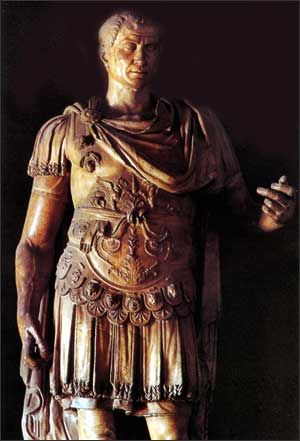Spot where Julius Caesar was stabbed discovered [see image]
Concrete structure believed to mark location of Roman ruler's killing
By Stephanie Pappas - Senior writer - MSNBC - October 11, 2012
Archaeologists believe they have found the first physical evidence of the spot where Julius Caesar died, according to a new Spanish National Research Council report.
Caesar, the head of the Roman Republic, was stabbed to death by a group of rival Roman senators on March 15, 44 B.C., the Ides of March. The assassination is well-covered in classical texts, but until now, researchers had no archaeological evidence of the place where it happened.
Now, archaeologists have unearthed a concrete structure nearly 10 feet wide and 6.5 feet tall that may have been erected by Augustus, Julius Caesar's successor, to condemn the assassination. The structure is at the base of the Curia, or Theater, of Pompey, the spot where classical writers reported the stabbing took place.
"We always knew that Julius Caesar was killed in the Curia of Pompey on March 15th 44 B.C. because the classical texts pass on so, but so far no material evidence of this fact, so often depicted in historicist painting and cinema, had been recovered," Antonio Monterroso, a researcher at the Spanish National Research Council, said in a statement.
Classical texts also say that years after the assassination, the Curia was closed and turned into a memorial chapel for Caesar. The researchers are studying this building along with another monument in the same complex, the Portico of the Hundred Columns, or Hecatostylon; they are looking for links between the archaeology of the assassination and what has been portrayed in art.
"It is very attractive, in a civic and citizen sense, that thousands of people today take the bus and the tram right next to the place where Julius Caesar was stabbed 2,056 years ago," Monterroso said.
.


4 comments:
Hey Camun, how is it going? I've taken somewhat of a long break from computers.
Certainly fascinating news, especially for those proud Ciociarians from Anagni and Alatri, probably the closest relatives alive to the original Latins and Volscians.
Also, some rather off-topic findings: Some cognomi have a very peculiar distribution---they have two nuclei(where they are almost exclusively found). One in Tuscany and the other in, well, Bresa province.
Go to gens labo and query the following: Bellandi, Piovanelli, Frizza(this one has a nucleus in Lucca, specifically in Val Camonica and also a third nucleus in Umbria). There are many more examples I've encountered, but unfortunately I didn't record and don't remember them.
Hello brother,
That's interesting also, because the Valle Sabbia (Brescia) was named after the Sabines.
http://en.wikipedia.org/wiki/Valle_Sabbia
The evidence suggests there were tribes of Alpines (Camunni, Trumpilini), Gauls (Cenomani, Orobii), and Latins (Sabini) occupying the same general area in various northern territories in pre-Roman times.
Are you referring to the surname database?
Perhaps you can write an article and I can post it here?
Bro, as far as your article offer goes, I will be contacting you shortly. Thank you so much for the opportunity.
Indeed, that bit about the Sabines is interesting. I would not be surprised if something similar applies to the Samnites(who are known to have migrated down the Appenines over the centuries).
And, yep! Definitely referring to that. There are actually two distinct surname databases featuring a map display. One is cognomix.it and the other one is gens labo. There is significant overlap, between the two, probably on the order of 95%, but one can sometimes include some rare cognomi the other omits.
They are useful in their own ways.
Gens labo(gens.info, then click on cognomi) is useful for getting an overall, but precise, idea of a surname’s geographical distribution across Italy. It’s not possible to determine the exact frequency of a surname in a particular hamlet, nor the name of the hamlet in question using that database, however. Type in “Casadei”, for a try. Yes, it’s one of those ethnic “marker” cognomi. Zanardelli is another good one. Carmassi is another---you probably know tons in the Bay Area.
Cognomix, on the other hand, provides the exact frequency of a given surname in a region, down to the hamlet, but it’s not possible to obtain a satisfactory overall picture without some mental gymnastics or a photographic memory. Remember how I told you about the actor Mark “Strong” Salussolia? I used cognomix to determine his father’s place of origin in a hamlet of Vercelli called Alice Castello. I was able to confirm this with some online gossip paragraphs written in Italian.
Speaking of confirmation, it’s always a good idea to use one database to confirm the other. But I also use a 3rd tool which is cognomiitaliani.org. Instead of providing a map-like interface or even numerical frequencies, this one is basically a dictionary of cognomi and their possible origin or where they are most likely to be found. It is written in Italian, yes, but one only needs to know what the words “piu”, “molto” and a few others mean to adequately understand it.
Yes, I'm familiar with the first two. They provide some great clues. www.cyndislist.com/italy/ is a good source.
My favorite database is the Camuno-Italiano translator http://www.intercam.it/vocab/ I've scanned over that, collectively, for hours and hours. I've even found errors with some obscure definitions, but he did a good job with it.
Any time you wish to write a Cisalpine-related posting, my new e-mail is camunlynx@live.com.
~for Kindred~
Joseph
Post a Comment